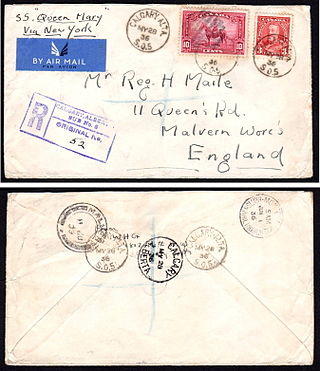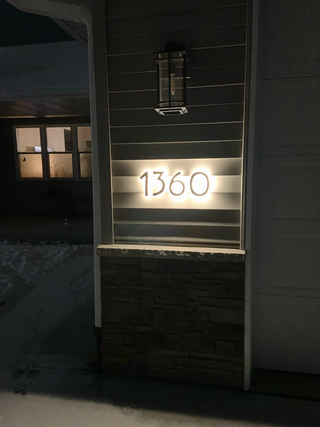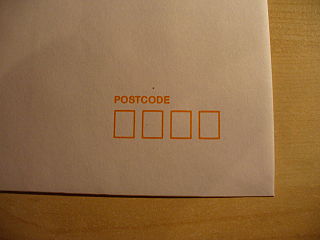
The United States Postal Service (USPS), also known as the Post Office, U.S. Mail, or Postal Service, is an independent agency of the executive branch of the United States federal government responsible for providing postal service in the U.S., its insular areas, and its associated states. It is one of the few government agencies explicitly authorized by the Constitution of the United States. As of 2023, the USPS has 525,469 career employees and 114,623 non-career employees.

A postal code is a series of letters or digits or both, sometimes including spaces or punctuation, included in a postal address for the purpose of sorting mail.

Postal codes used in the United Kingdom, British Overseas Territories and Crown dependencies are known as postcodes. They are alphanumeric and were adopted nationally between 11 October 1959 and 1974, having been devised by the General Post Office. A full postcode is known as a "postcode unit" and designates an area with several addresses or a single major delivery point.

The London postal district is the area in England of 241 square miles (620 km2) to which mail addressed to the London post town is delivered. The General Post Office under the control of the Postmaster General directed Sir Rowland Hill to devise the area in 1856 and throughout its history it has been subject to reorganisation and division into increasingly smaller postal units, with the early loss of two compass points and a minor retraction in 1866. It was integrated by the Post Office into the national postcode system of the United Kingdom during the early 1970s and corresponds to the E, EC, N, NW, SE, SW, W and WC postcode areas. The postal district has also been known as the London postal area. The County of London was much smaller, at 117 square miles (300 km2), but Greater London is much larger at 607 square miles (1,570 km2).

A Canadian postal code is a six-character string that forms part of a postal address in Canada. Like British, Irish and Dutch postcodes, Canada's postal codes are alphanumeric. They are in the format A1A 1A1, where A is a letter and 1 is a digit, with a space separating the third and fourth characters. As of October 2019, there were 876,445 postal codes using Forward Sortation Areas from A0A in Newfoundland to Y1A in Yukon.

Royal Mail Group Limited, trading as Royal Mail, is a British postal service and courier company. It is owned by International Distributions Services. It operates the brands Royal Mail and Parcelforce Worldwide (parcels). The company used the name Consignia for a brief period in the early 2000s.

This is a survey of the postage stamps and postal history of the Falkland Islands.

Registered mail is a postal service in many countries which allows the sender proof of mailing via a receipt and, upon request, electronic verification that an article was delivered or that a delivery attempt was made. Depending on the country, additional services may also be available, such as:
The Postcode Address File (PAF) is a database that contains all known "delivery points" and postcodes in the United Kingdom. The PAF is a collection of over 29 million Royal Mail postal addresses and 1.8 million postcodes. It is available in a variety of formats including FTP download and compact disc, and was previously available as digital audio tape. As owner of the PAF, Royal Mail is required by section 116 of the Postal Services Act 2000 to maintain the data and make it available on reasonable terms. A charge is made for lookup services or wholesale supply of PAF data. Charges are regulated by Ofcom. It includes small user residential, small user organisation and large user organisation details. There have been requests as part of the Open Data campaign for the PAF to be released by the government free of charge.
Poste restante, also known as general delivery in North American English, is a service where the post office holds the mail until the recipient calls for it. It is a common destination for mail for people who are visiting a particular location and have no need, or no way, of having mail delivered directly to their place of residence at that time.

An address is a collection of information, presented in a mostly fixed format, used to give the location of a building, apartment, or other structure or a plot of land, generally using political boundaries and street names as references, along with other identifiers such as house or apartment numbers and organization name. Some addresses also contain special codes, such as a postal code, to make identification easier and aid in the routing of mail.
A post town is a required part of all postal addresses in the United Kingdom and Ireland, and a basic unit of the postal delivery system. Including the correct post town in the address increases the chance of a letter or parcel being delivered on time. Post towns in general originated as the location of delivery offices. As of 2004, their main function is to distinguish between localities or street names in addresses not including a postcode.

Military mail, as opposed to civilian mail, refers to the postal services provided by armed forces that allow serving members to send and receive mail. Military mail systems are often subsidized to ensure that military mail does not cost the sender any more than normal domestic mail. In some cases, military personnel in a combat zone may post letters and packages to their home country free of charge. Modern military mail services are provided by most armed forces around the world. In some nations, individual service branches may run their own military mail program.

The Isle of Man Post Office, which formerly used the trading name Isle of Man Post, operates postal collection, ancillary mail services, philatelic goods and delivery services and post office counter services on the Isle of Man.
Loamshire Regiment is a placeholder name used by the British Army to provide examples for its procedures. For example, the Loamshire Regiment is provided by the British Forces Post Office to show how to write a British Army address, and is used to set out specimen charges for violations of military law. It is used in Hesketh Hesketh-Prichard's Sniping in France, a World War One manual for training British Army sharpshooters.
Using violence towards his superior officer contrary to section 33(1)(a) of the Army Act 1955 in that he at- on- [struck] [punched] [kicked] No 12345678 Sergeant J Brown, The Loamshire Regiment.
The BT postcode area, also known as the Belfast postcode area, covers all of Northern Ireland and was the last part of the United Kingdom to be coded, between 1970 and 1974. This area is a group of 82 postcode districts in Northern Ireland, within 44 post towns and around 47,227 live postcodes.

Postcodes in Australia are used to more efficiently sort and route mail within the Australian postal system. Postcodes in Australia have four digits and are placed at the end of the Australian address, before the country. Postcodes were introduced in Australia in 1967 by the Postmaster-General's Department and are now managed by Australia Post, Australia's national postal service. Postcodes are published in booklets available from post offices or online from the Australia Post website.

Package tracking or package logging is the process of localizing shipping containers, mail and parcel post at different points of time during sorting, warehousing, and package delivery to verify their provenance and to predict and aid delivery.

The postal service of the British Army is today provided by the British Forces Post Office but its origins may be traced back to Saxon times.















